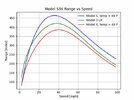Good day everyone!
Living in a hilly area (many >25% grades) in a city with 50km/h - 60km/h (30mi/h - 40mi/h) speed limit. In most areas there is no traffic to keep up with, so have flexibility to vary my speed between 50% and 100% of the speed limit. The car is mostly lightly loaded, if not just the driver and a passager.
From looking at charge speed efficiency in the past, I remember at very low speeds the charging efficiency is not great due to the constant losses. With faster charging speeds, the losses are smaller percentage even if as absolute value they are similar. On the other hand, in general, the car is most efficient (kWh/mi) at lower speeds.
While there may be little practical value, still interested in what is the best speed on descends to recapture the most energy and similarly, wonder what the optimal speed for ascend is. For example, not sure if driving longer time at lower speed on descend is better than shorter time at higher speed. Similarly should I go as slow as practical on ascends?
Living in a hilly area (many >25% grades) in a city with 50km/h - 60km/h (30mi/h - 40mi/h) speed limit. In most areas there is no traffic to keep up with, so have flexibility to vary my speed between 50% and 100% of the speed limit. The car is mostly lightly loaded, if not just the driver and a passager.
From looking at charge speed efficiency in the past, I remember at very low speeds the charging efficiency is not great due to the constant losses. With faster charging speeds, the losses are smaller percentage even if as absolute value they are similar. On the other hand, in general, the car is most efficient (kWh/mi) at lower speeds.
While there may be little practical value, still interested in what is the best speed on descends to recapture the most energy and similarly, wonder what the optimal speed for ascend is. For example, not sure if driving longer time at lower speed on descend is better than shorter time at higher speed. Similarly should I go as slow as practical on ascends?



